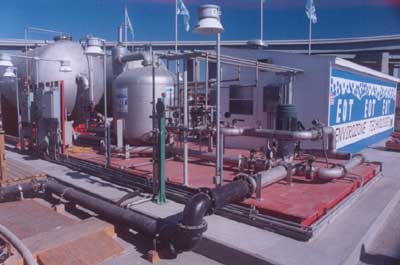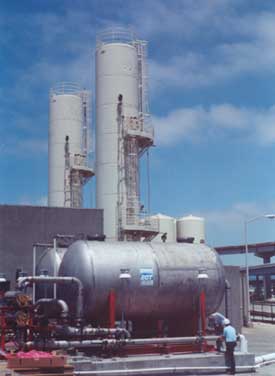Advanced Oxidation Process Performs Well in Significant Municipal Wastewater Pilot Test

Combining processes that incorporate ozone, ultraviolet (UV) radiation, and a re-circulation feature, the system was developed to treat secondary effluent and achieve high contaminant removal efficiencies. It provides deodorization, color removal and the oxidation of organic chemical contaminants in addition to its primary function of disinfection. This pilot plant, consisting of four skid-mounted modules and occupying only 1600 square ft of floor space, is said to be the first of its kind to be tested in real world conditions.
District Anticipates Risks, Looks for Improved Economics
The EO3T firm was selected by EBMUD to participate in an Alternative Disinfect Study (ADS) in 1996 because of the District's growing concerns about the possible risks associated with the transportation, storage and handling of the chlorine gas and sulfur dioxide used in disinfection. Beyond that EBMUD's management was concerned about the increasing costs of disinfection, and the problems of halogenated disinfection by-products (DBPs) that remained as a residual after the disinfection process was switched to a sodium hypochlorite/sodium bisulfite system.
Subsequently a small 10-gpm pilot system using ozone, UV and hydrogen peroxide was installed to determine whether synergies existed between any two of these powerful oxidants and disinfectants. Results gathered from that pilot test effort suggested that the combination of ozone and low pressure UV was the most effective disinfection process for the District's typical conditions and met its fecal coliform standard of 500 MPN/100ml.

In this view of the pilot facility from the end where the secondary effluent is introduced, the system's pump, mixing tank and vent tank are seen in front of the two retention vessels.
EBMUD's Board of Directors then decided to test a larger system when they became aware of advances made in ozone production technology and related cost reduction possibilities. In addition the board wanted to test a medium pressure UV system and to evaluate the additional benefits of ozone for the destruction of complex organic compounds. To pursue the evaluation of the process to the next level a 1000-gpm advanced oxidation system was designed and built by EO3T, and placed in operation at the Main Wastewater Treatment Facility in September 1998. The manufacturer provide resident staff to run the pilot plant, while the necessary analytical work was carried out by the wastewater facility's laboratory
Pilot Plant Designed to Provide Broad Evaluation Base
Influent to the pilot plant was un-chlorinated secondary effluent at 50-65 pounds per square inch (psi) flowing at 725 to 800 gpm. Design flow rate is 1000 gpm. The pilot system was designed to operate at various pressures, flow rates, ozone contact times, ozone concentrations and UV dosages. This versatility provided a broad evaluation base so that the efficiency and effectiveness of the ozone and UV processes could be studied.
By-pass and re-circulation capability was built in to provide additional operational flexibility. An optional booster pump was included to increase inlet pressure to 80 pounds per square inch (psi) or for re-circulation, if desired. Also, three water-cooled ozone generators with a combined capacity of 261 lbs/day at a 10% concentration were installed. Oxygen was fed to the ozone generators from the existing oxygen plant. During operations two of these ozone units were running while the third remained in stand-by mode.
The pilot plant (see schematic below) process begins where ozone gas is introduced to the secondary effluent stream through via two in-line Mazzei venturi-effect injectors. These create a vacuum that draws the ozone into the liquid as it passes. Micro-bubbles of ozone provide a large surface area for the gas-to-liquid transfer. Now dissolved in the wastewater stream, ozone enters a mixing tank for a contact time of about a minute and a half, which allows the oxidation reaction to proceed. Excess gases are removed in an off gas destruct unit while the ozone-laden liquid enters two 10,000-gallon retention tanks piped in series for additional contact time and further oxidation of organic material.

This schematic diagram shows the key components of the advanced oxidation
process pilot plant as installed at the EBMUD site.
The contact time can be adjusted to between two and 27 minutes based on the complexity of the influent wastewater and calculated oxidation requirements. The oxidation process also increases the transmittance of the liquid by lowering the turbidity, thus improving the efficiency of the UV radiation system.
After passing through the retention tanks the effluent flows through either a low-pressure UV unit or a medium pressure UV unit. The pilot plant was equipped with the dual UV systems to evaluate the effectiveness and efficiency of each. The ultraviolet lamps are separated from direct contact with the liquid by quartz sleeves that are cleaned periodically by automatic wipers. Combining ozone and UV has the effect of producing hydroxyl radicals, which greatly intensifies the disinfection/oxidation properties of the system.

The two people in this photo provide an illustration of the scale of the test facility, and especially the retention tanks.
Flow meters, along with ozone concentration, pressure and temperature monitoring instruments, are located throughout the system. Sampling ports are distributed at significant points along the process train. Safety and maintenance alarms and indicators are provided to ensure operational safety.
Test Protocol Comprised Five Phases
The pilot testing protocol was divided into five phases. A Preliminary Phase was designed to obtain data from a wide variety of tests. The tests included fecal coliform, UV transmittance, chemical oxygen demand (COD), nitrite, total suspended solids (TSS), volatile organic compounds (VOC), semi-VOCs and pesticides. A special study was conducted to determine the system's effectiveness in the removal of MTBE (methyl tertiary butyl ether}.
Phase One studied the effects of ozone dosage (5 to 20 mg/l) and retention time (2 to 27 minutes). Phase Two focused on the effects of UV dose (30-150 mj/cm2). Phase Three evaluated different ozone gas concentrations (7 to 10%) and UV influent pressures (15 and 20 psi). Phase Four measured the effectiveness of the system operating 24 hours per day at resulting optimal settings of 10 ppm of ozone at 7% concentration and UV influent pressure of 15 psi.
The following table summarizes the success of the system in dealing with municipal secondary wastewater. It shows the percent reduction achieved by the advanced oxidation pilot plant in dealing with fecal coliform and organic compounds when the ozone concentration was 15 mg/l and the retention time two minutes.

In relation to fecal coliform the system consistently met or bettered the performance requirements of EBMUD's discharge permit, frequently producing discharges with coliform values that were less than 10% of the limit. This was accomplished without the introduction of chemicals and with no potentially harmful disinfection by-products produced.
Organic compound removal was accomplished effectively. The system reduced 12 of the unwanted organic compounds detectable in the pilot plant influent to a significant degree. In one test MTBE was reduced by nearly 70%. The concentrations of some benign biodegradable compounds were increased. These are intermediate products formed in the oxidation process.
Demonstrated Performance Points to Future Potential
Performance was beyond expectations. The scalability of the process, in this case from 10 gpm to 1000 gpm, was demonstrated in a true municipal wastewater treatment environment. The flexibility that allows the system to operate in various modes is predicted to be suitable for meeting the discharge requirements of a broad mix of urban municipal, agricultural and industrial settings.
The economics of the system are determined in terms of the target effluent quality and the cost of energy at the site. Numbers produced during the EBMUD test indicated that a complete 55,000-gpm system would operate for a cost of $0.07/1000 gallons.
The EBMUD pilot test of Envirozone Technologies' advanced oxidation process for disinfection, deodorization, color reduction, and removal of organic chemicals by oxidation, appears to have demonstrated that a variety of potential applications exists in many wastewater treatment scenarios, and possibly also in the drinking water field. To take the investigation to another stage, the pilot plant is about to be moved to a wastewater district serving Sacramento, CA area. It will be tested against the local conditions in that area.
Increased concern over the use of chemicals and the potential for the creation of harmful disinfection by-products is encouraging many municipal, agricultural and industrial entities to look for other means to treat their wastewater effectively, and ultimately to provide the groundwork for reuse. The process described appears to have the potential to be combined with other water/wastewater treatment systems, for instance reverse osmosis, activated charcoal and various forms of filtration, to produce high levels of performance and water quality.
Editor's Note: This article was based upon the 1,000-gpm Pilot Study Final Report prepared by EO3T staff—Rafi M. Salem, president; Dr. Frank X. Stuart, technical adviser; James A. Purcell, consultant; and Colleen Torrenga, technician. The Walnut Creek, CA firm may be contacted at phone 925-945-6088; fax 925-945-6089; e-mail: eot@best.com, for more information.
Edited by Ian Lisk, Editor Emeritus, Water Online
